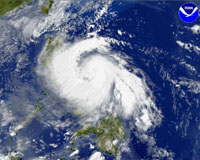| . |  |
. |
Madrid, Spain (SPX) May 28, 2009 The Mediterranean region is a very active cyclone area, and is often affected by these atmospheric phenomena, which bring strong winds and heavy rain. Despite the efforts of the scientific community to improve numerical cyclone prediction, the systems developed are costly. "Sensitivity studies are a low-cost and efficient way of establishing the best kinds of observation strategies", Lorena Garcies, lead author of the study and a researcher in the Meteorology Group at the University of the Balearic Islands (UIB), tells SINC. The study, which has been published in the latest issue of Tellus Series A-Dynamic Meteorology and Oceanography, shows that analyses of atmospheric sensitivity are useful for designing "efficient" observation networks based in Europe, and strategies that can be adapted to "especially dangerous" events. "Areas with low levels of in situ measurements, such as northern Africa, the Mediterranean Sea and the north east Atlantic, are important areas in the prediction of intense, short-range Mediterranean cyclones", says V�ctor Homar, another of the study's authors and a researcher at the UIB.
Measuring the 'sensitivities' of the atmosphere With this method, the scientists are able to improve the prediction of cyclones' development and impact between 48 and 24 hours before they fully form. Temperature and wind speed are also important factors in predicting this high-impact phenomenon. "The results for intense Mediterranean cyclones show dynamic, spatial and temporal coherence between the sensitivity fields, and are consistent with similar results obtained by using much more expensive sensitivity techniques", Garcies and Homar point out. The researchers are inviting the network of European Meteorological Institutes (EUMETNET) to use this new system to help improve observation systems over the regions of western Europe, northern Africa and the Atlantic Ocean, and "to bring about a systematic improvement in the forecasting of high-impact events in the Mediterranean". Forecasting is improved by increasing the observations within data assimilation systems, but Garcies believes that "building up in situ observations to the same levels over all areas is an unachievable goal, because it is incompatible with growing public demand for improved forecasts with maximum efficiency but at the lowest cost".
Share This Article With Planet Earth
Related Links FECYT - Spanish Foundation for Science and Technology Bringing Order To A World Of Disasters When the Earth Quakes A world of storm and tempest
 Japan funds Philippines' typhoon alert upgrade
Japan funds Philippines' typhoon alert upgradeManila (AFP) May 27, 2009 Japan on Wednesday extended a two billion-peso (42.3 million-dollar) grant to the Philippines to help it improve its defences against deadly typhoons, the Filipino government said. The grant package from the Japan International Cooperation Agency (JICA) includes funding for a 1.6 billion-peso project to replace three meteorological alert systems along the country's Pacific Ocean coast. ... read more |
|
| The content herein, unless otherwise known to be public domain, are Copyright 1995-2009 - SpaceDaily. AFP and UPI Wire Stories are copyright Agence France-Presse and United Press International. ESA Portal Reports are copyright European Space Agency. All NASA sourced material is public domain. Additional copyrights may apply in whole or part to other bona fide parties. Advertising does not imply endorsement,agreement or approval of any opinions, statements or information provided by SpaceDaily on any Web page published or hosted by SpaceDaily. Privacy Statement |